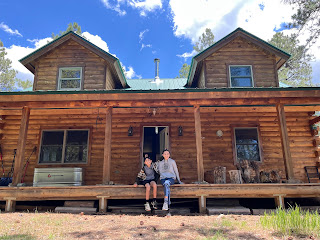From the Appalachian Mountains to the Rocky Mountains: Colorado is our happy place.
Almost five years ago, we drove through a quaint town in Southwestern Colorado. We fell in love with the small town of Pagosa Springs and the surrounding San Juan mountains. We have been going back at least a couple times a year ever since.
As the kids wrapped up homeschooling, we got our library cards from the local library. We visited twice a week and got to know the librarians. We stayed at our friend's cabin while they were away and got to really immerse ourselves in the peace and quite of the forest property. We explored the national forest and took long walks, we got to practice high altitude baking, cooked a lot, read, played board games, crafted, and ended our days with many movie nights. The cozy cabin was exactly what we needed to relax and reflect.
We gave ourselves a month to decompress, but of course, we also adventured! Every few days, we set out to explore a different area of the San Juan Mountains.
1. Buckles Lake and Harris Lake: At 9,700 ft. at the trailhead, the hike to the lakes is easy and beautiful. We walked through massive pines and large aspen groves. As we hiked further up, we were surprised to still see snow in the early summer. This was an out and back for four miles. Perfect for an afternoon walk in the southern San Juan Mountains.
*****
2. Fourmile Falls: One of the most popular hikes in the area is to Fourmile Falls. Somewhat challenging with the 1,000 ft. altitude gain over three miles. The early summer wildflowers were lovely with the still snow capped mountains in the background. The weather was perfect, high in the 70s to low 80s. The 300 ft. falls is a show stopper falling from almost 10,000ft. This hike is absolutely worth the drive and the walk.
*****
3. Opal Lake: Don't be fooled by this 1.2 mile hike. It was a consistent climb up to a small lake in the mountains. Kaia took the lead and kept a fast space. The lake is small but set in the most stunning background: layers of pines and aspen reflecting off the lake. The trail proper ended 1/3 of the way around the lake so we had to bush whack the rest of the way to go all the way round it.
*****
4. Continental Divide Trail: We took the kids to the CDT, one of the three long distance trail in the US. It is around 3,100 miles from Mexico to Canada. There was still a lot of snow left on the trail. What's amazing about the CDT is that it is a "choose your own adventure" hike. Unlike the Appalachian Trail where the way is marked with white blazes, you need a map and compass or GPS to navigate the Rockies. We saw several hikers in town resupplying. Navigating your way on foot through the Rockies is no easy feat. When we saw a hiker in town, I got goosebumps thinking about their journey from Mexico and onward. I know it is crazy hard but what an adventure.
*****
5. Wolf Creek: while hiking on the CDT, we got off the trail a bit where the snow was still deep and ran into a "ski boundary" sign. We stumbled into the Wolf Creek Ski area where we ski during Spring Break! We walked up one of the ski runs that we frequent and made our way to one of the lodges. It was awesome to hike the routes we ski with our kids. We heard thunder in the distance so we made our way down quickly since we were exposed at over 10,000ft.
*****
6. Treasure Falls: We've driven by Treasure falls a dozens of times but never stopped because it is always so busy. At only .2 mile from the parking lot, it just never appealed to us. But we stopped this time and it was nice. The waterfall was running full and it was tall. This is an easy one to visit and it is pretty.
*****
7. Piedra Falls/Piedra Trail: This was our second time at Piedra Falls. We had friends visiting us and we wanted to take them on a short hike. It's over an hour drive to get there but the hike is only half a mile. The falls were flowing like a raging river and then it started hailing on us! Thank goodness we always bring our gear because we needed it. The temperature within that hour dropped 25 degrees, from 80 to 55 in no time. It was fun walking through the hail. June in Colorado is wild and fun.
*****
8. Piedra Trail: This is probably our favorite trail in the Pagosa Springs area. The box canyons with the Piedra River running through it does not disappoint. Our first time walking it, we had brought our fly fishing poles and walked eight miles out and back while crossing the river more than a dozen times. This trail is fairly easy in the best mix of river canyon, meadows, and forest.
*****
In a month, we covered a lot of ground! We got to all the places we've passed by over the years and didn't have time to explore. There's also the hot springs and endless fishing opportunities in the San Juan River. We've also covered many sections of the river for fly fishing.
Even though we were active, we also had a lot of downtime in the cabin. It was wonderful to have he time to relax and reflect on our incredible year.
There is so much to do in southwestern Colorado, it is an absolute stunner in the winter and in the summer. We can't wait to go back.
























































